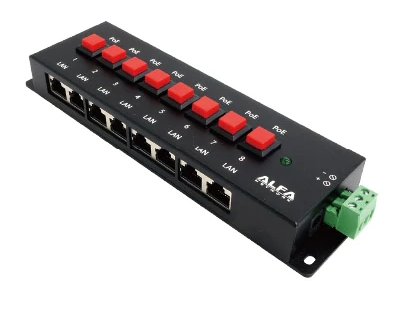Power over Ethernet (PoE) is the technology that enables transmission of electrical power, along with data signals, over standard Ethernet cables. It allows network devices, such as IP phones, wireless access points, and security cameras, to receive power directly from a PoE-enabled network switch or injector, eliminating the need for separate power cables.

APoE08 8 Port Power Over Ethernet (POE) Switch
There are several standards for POE, which specify the maximum amount of power that can be delivered over Ethernet cables. Here are the four main POE standards:
1. IEEE 802.3af (PoE):
- Power Delivery: Up to 15.4W of DC power per port (min of 12.95W guaranteed at the powered device).
- Supply voltage of 44-57V DC, current, 0.1-0.35A
- Pin Configuration: Mode A or Mode B.
- Powering Options: Delivers power over the same pairs used for data transmission (pins 1, 2, 3, and 6 in Mode A or pins 4, 5, 7, and 8 in Mode B).
- Ethernet Cable: Utilizes Category 3 or higher-grade cables (e.g., Cat 5, Cat 5e, or Cat 6) for power and data transmission.
- Typical Use Cases: IP phones, wireless access points, and low-power network devices.
2. IEEE 802.3at (PoE+):
- Power Delivery: Up to 30W of DC power per port (min of 25W guaranteed at the powered device).
- Supply voltage of 50-57V DC, current 0.01-0.6A
- Pin Configuration: Mode A or Mode B.
- Powering Options: Supports both Mode A and Mode B power delivery.
- Ethernet Cable: Utilizes Category 5e or higher-grade cables (e.g., Cat 6 or Cat 6a) for power and data transmission.
- Typical Use Cases: High-power wireless access points, pan-tilt-zoom (PTZ) IP cameras, LCD displays, biometric sensors and advanced network devices requiring higher power levels.
Note: PoE+ (IEEE 802.3at) is backwards compatible with POE (IEEE 802.3af) meaning it will power even legacy POE power devices.
3. IEEE 802.3bt (PoE++, 4PPoE, or Type 3/ 4 PoE):
- Power Delivery - Provides two power levels:
- Type 3: Up to 60W of DC power per port (min of 51W guaranteed at the powered device).
- Type 4: Up to 100W of DC power per port (min of 71W guaranteed at the powered device).
- Pin Configuration: Mode A or Mode B.
- Powering Options: Supports both Mode A and Mode B power delivery.
- Ethernet Cable: Utilizes Category 5e or higher-grade cables (e.g., Cat 6 or Cat 6a) for power and data transmission.
- Typical Use Cases: High-power devices such as video conferencing systems, lighting systems, and industrial applications.
Note: (IEEE 802.3bt) is backwards compatible with both IEEE 802.3af and IEEE 802.3at meaning it will power even legacy POE power devices.
4. UPoE (Cisco Ultra-PoE):
This is a proprietary standard developed by Cisco that provides up to 60 watts of power per port. It is similar to IEEE 802.3bt, but it uses a different power management system.
Note that the power sourcing equipment (PSE), such as a PoE-enabled switch or injector, must comply with the corresponding PoE standard to ensure compatibility with powered devices (PDs). Additionally, PDs must also adhere to the specific PoE standard requirements to receive power safely and efficiently over Ethernet cables.
| Type | Standard | PD Min. Power Per Port | PSE Max. Power Per Port | Cable Category | Power Over Pairs |
|---|---|---|---|---|---|
| Type 1 | IEEE 802.3af | 12.95W | 15.4W | Cat5e | 2 pairs |
| Type 2 | IEEE 802.3at | 25W | 30W | Cat5e | 2 pairs |
| Type 3 | IEEE 802.3bt | 51W | 60W | Cat5e/ Cat6 | 2 pairs class 0-4, 4 pairs class 5-6 |
| Type 4 | IEEE 802.3bt | 71W | 100W | Cat5e/Cat6 | 4 pairs class 7-8 |
These standards allow network administrators to power a wide range of devices through Ethernet cables, reducing the need for separate power supplies and making network deployments more flexible and efficient.
Check out our storewide PoE products that suit your application here:
Here are a couple articles to guide you through selecting proper POE Power Sourcing Equipment for your next project:

